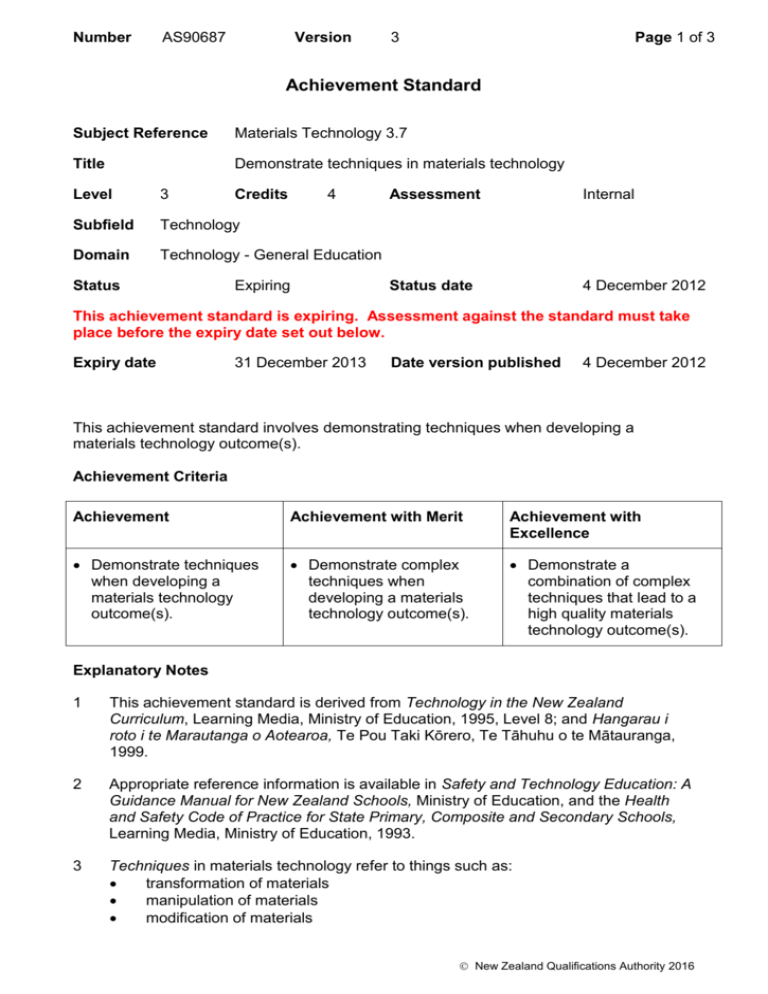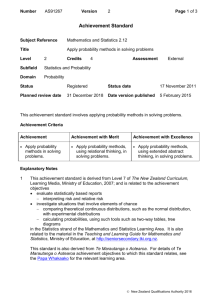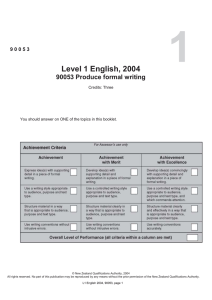90687 Demonstrate techniques in materials technology
advertisement

Number AS90687 Version 3 Page 1 of 3 Achievement Standard Subject Reference Materials Technology 3.7 Title Demonstrate techniques in materials technology Level 3 Subfield Technology Domain Technology - General Education Status Credits 4 Expiring Assessment Internal Status date 4 December 2012 This achievement standard is expiring. Assessment against the standard must take place before the expiry date set out below. Expiry date 31 December 2013 Date version published 4 December 2012 This achievement standard involves demonstrating techniques when developing a materials technology outcome(s). Achievement Criteria Achievement Achievement with Merit Achievement with Excellence Demonstrate techniques when developing a materials technology outcome(s). Demonstrate complex techniques when developing a materials technology outcome(s). Demonstrate a combination of complex techniques that lead to a high quality materials technology outcome(s). Explanatory Notes 1 This achievement standard is derived from Technology in the New Zealand Curriculum, Learning Media, Ministry of Education, 1995, Level 8; and Hangarau i roto i te Marautanga o Aotearoa, Te Pou Taki Kōrero, Te Tāhuhu o te Mātauranga, 1999. 2 Appropriate reference information is available in Safety and Technology Education: A Guidance Manual for New Zealand Schools, Ministry of Education, and the Health and Safety Code of Practice for State Primary, Composite and Secondary Schools, Learning Media, Ministry of Education, 1993. 3 Techniques in materials technology refer to things such as: transformation of materials manipulation of materials modification of materials New Zealand Qualifications Authority 2016 Number AS90687 Version 3 Page 2 of 3 transformation skills: eg joining or laminating materials to develop different performance properties such as in the use of layering textiles (interfacings, interlinings and linings) in tailoring; or the lamination of timbers to produce compound curves; or the use of fibre reinforced plastics to improve strength and stability of resins manipulation skills: eg cutting, machining and assembly of component parts within specified tolerances, drafting and/or adaptation of patterns in the interpretation of original designs to enable assembly of the component parts; managing to shape and structure textiles in garment construction; incorporating difficult-to-handle materials successfully into products, eg textiles such as sheers, velvets into a garment, joining and machining of stainless steel, cutting and assembly of compound mitre joints modification skills to change a material’s: form, eg from flat sheet to corrugated, woollen yarn into felt properties, eg hardness, physical state, brittleness, colour, density, malleability, ductility, surface texture; use of embellishment techniques, changing wool fibre into fire resistance woollen insulation materials. 4 Technique refers to a combination of skills carried out in a particular order for a particular purpose. The selection of techniques is context specific. Complex techniques require a combination of techniques carried out in a particular order for a particular purpose. 5 A high quality materials technology outcome is one that is fully fit for purpose, and in addition displays attributes that show a combination of complex techniques have been implemented successfully. ‘Fit for purpose’ is a term used to judge the ability of the materials technology outcome to serve its purpose to ‘do the job’ within the intended location, where the ‘job to be done’ is clearly defined by the brief. Referring to ‘fit for purpose’ in its broadest sense within technology education, extends this usage to include the determination of the fitness of the practices involved in the development of the materials technology outcome, as well as the fitness of the materials technology outcome itself, for the identified purpose. Exploration of relevant codes of practice, legal requirements and understandings of ethical and cultural ways of practising, will therefore be important aspects of establishing ‘fit for purpose’. In demonstrating ‘fit for purpose’ the student is expected to incorporate and evaluate feedback from relevant stakeholders. 6 Techniques in materials technology may be demonstrated in the production of models, prototypes, one-off solutions or products from multi-unit production. 7 Techniques performed need to be performed in keeping with relevant codes of practice that include: legal responsibilities including: Acts (eg Fair Trading Act 1986, Consumer Guarantees Act 1993, Health and Safety in Employment Act 1992, Privacy Act 1993, Employment Relations Act 2000, Resource Management Act 1991, Hazardous Substances and New Organisms Act 1996) Standards (eg ISO standards – 9000, 14000 series, Standards New Zealand (SNZ) standards) ethical responsibilities including: professional (eg stipulated by codes of ethics developed by professional associations) New Zealand Qualifications Authority 2016 Number AS90687 Version 3 Page 3 of 3 cultural and/or religious (eg in keeping with the accepted practices of cultures and religions) moral responsibilities driven by the beliefs and values of the technologist. Replacement Information This achievement standard has been replaced by AS91621 and AS91623. Quality Assurance 1 Providers and Industry Training Organisations must have been granted consent to assess by NZQA before they can register credits from assessment against achievement standards. 2 Organisations with consent to assess and Industry Training Organisations assessing against achievement standards must engage with the moderation system that applies to those achievement standards. Consent and Moderation Requirements (CMR) reference 0226 New Zealand Qualifications Authority 2016











